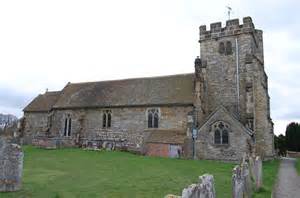VOLUME III
Bartons of Warbleton.
Volume III covers what little is known about my paternal grandfather James Richard Barton and his
James Richard Barton married Gracie Joan Ponting on 24 April 1926 at Wartling Parish Church (Chapter 14).
I have named this Volume "Bartons of Warbleton". Although not all Barton births, marriages and death's took place in Warbleton, the
Warbleton is a parish in the Hawkesborough Hundred and Rape of Hastings, it is 7 miles north from Hailsham and 3 miles south from Heathfield in the Eastern division of Sussex. The parish consists of two villages, Rushlake
"Hundreds" emerged in the tenth century as an important unit of local administration and were named as such because the area in question was supposed to maintain 100 families, although their origins are obscure. Even though by Tudor times, parishes had taken over as the fundamental unit of local government, the divisions were maintained.
"Rapes" were created soon after the Battle of Hastings, certainly by 1086 and probably by 1067, when William the Conqueror subdivided Sussex into five administrative divisions, running from North to South of the county, each based on a port and controlling one of the highways to the North and gave one to each of his most trusted barons, the Rape of Hastings being given to the Earl of Eu. This was to protect communication routes to Normandy in the face of sporadic resistance to the conquering Norman's, but also served to keep the Barons too busy for them themselves to think of revolt.
The church of St. Mary's, Warbleton is built on a Neolithic mound and the chancel and nave date from the 13th century. nave, chancel, north aisle, and square tower containing 6 bells, all thirteenth century. The porch and north aisle were added in the 14th century and the square tower containing 6 bells in the 15th century. The parish
There is also a church at St John the Evangelist at Bodle Street Green, which is within the parish and shares the same vicar.

Volume III is arranged as follows:
- Chapter 1 - The Early Generations
- Chapter 2 - John Barton and Catherine Keeley
- Chapter 3 - James Barton and Orpah Crowhurst
- Chapter 4 - John Henry Barton and Caroline Wood
- Chapter 5 - James Richard Barton and Gracie Joan Ponting
- Appendix A - The descendants of Jenny Sweetnam nee Barton
- Appendix B - Keeley
- Appendix C - The children of Stephen Catt and Ann Barton
- Appendix D - The children of James Catt and Hannah Barton
- Appendix E - The children of John Barton and Elinor Crowhurst
- Appendix F - The children of Thomas Barton and Elendor Tedham
- Appendix G - The children of Peter Bourner and Sarah Barton
- Appendix H - The children of William Unsted and Jane Barton
Appendix K - The children of William Frederick Jarman and Dorcus Barton
Appendix L - The children of William Elphick and Rhoda Barton
- Appendix M - Wood
- Appendix N - The children of John Henry Barton and Caroline Wood